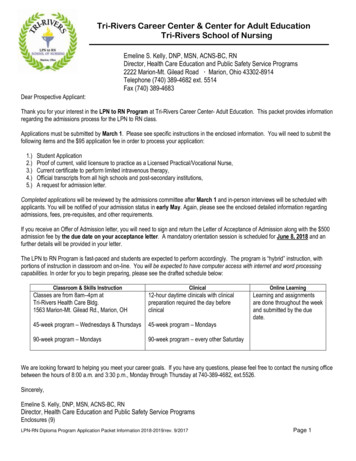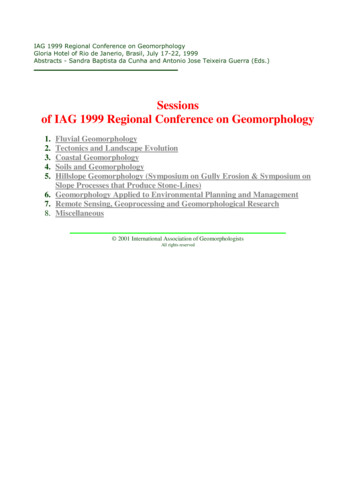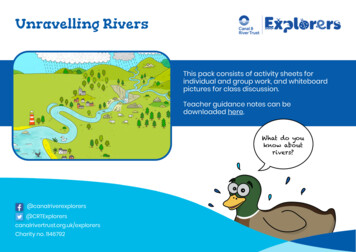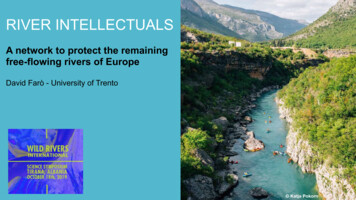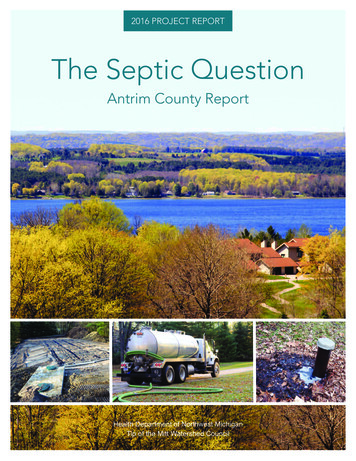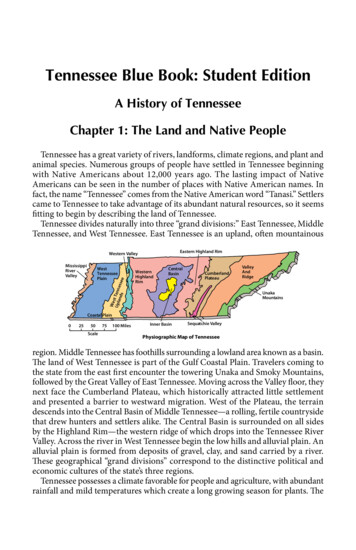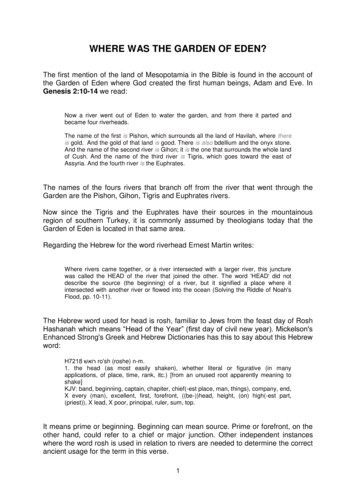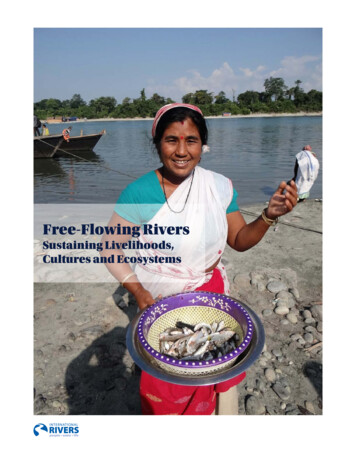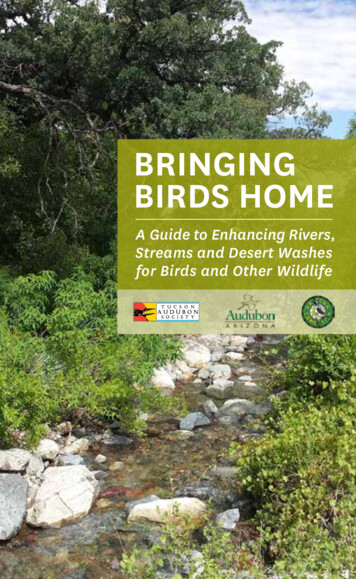
Transcription
BRINGINGBIRDS HOMEA Guide to Enhancing Rivers,Streams and Desert Washesfor Birds and Other Wildlife
INTRODUCTIONArizona contains amazingly diverse habitats—from mountains withmoist canyons to grasslands to parched deserts. Many kinds of plantsand animals call these habitats home; the sheer variety of habitatshelped Arizona become world famous for the number of bird speciesfound in the state. In an arid environment, the water and rich vegetationalong Arizona’s rivers, creeks, wetlands, lakes, ponds, and washes(riparian areas) draw in the highest diversity of birds. This guide aimsto help landowners and residents who live along riparian areas toconserve, enhance, and restore habitat specifically to benefit birds.In so doing, you will also create habitat for an incredible variety ofmammals, reptiles, amphibians, and insects.Your actions will help ensure Arizona’s waterways remain healthy.Keeping riparian areas healthy is important for many reasons: Riparian vegetation helps control flood events. Stabilizes river banks, traps nutrients and soil, and improves waterquality. Improves water quality, provides shade, moderates temperatures,and helps keep the water table high. Riparian areas provide multiple uses and enjoyment to people.Let’s get started!Aravaipa Creek, J. MacFarlandAreas with water, like this stretch of Aravaipa Creek, are rare and precious inArizona. They provide excellent recreation opportunities, increase the valueand beauty of private property, and provide homes for wildlife. They are worthprotecting and enhancing!Bringing Birds Home Riparian1
What is a Riparian Area?Desert WashWashes that runthrough the desertonly have waterafter it rains, butthese areas stillsupport largertrees than theirsurroundings andprovide shade andshelter for animalsand people.2 Bringing Birds Home RiparianArivaca Cienega, Matt GriffithsSpringsWater bubbling upfrom a spring cancreate green areasthat are very productive for wildlife.Desert wash in Tumacacoris, J. MacFarlandPerennial RiverRiver with yearround water thatsupports largetrees and manyother plants.Lower San Pedro River, J. MaacFarlandRiparian areas are spots that have water at least part of the year. Theyare home to plants and animals that need more moisture than availablein their surroundings. In Arizona, riparian areas border flowing streams,rivers, and even desert washes (which have flowing water only a fewdays per year).
Your Riparian Habitat—Why Do We Need It?All the plants that grow along rivers and streams help stabilize thebanks. Without this vegetation, seasonal floods can cause severeerosion and result in lowered water tables and decreased water quality.Native vegetation along riverbanks helps slow and spread flowing water,which reduces the chances of a damaging flood event. This also allowssoil particles to deposit on the floodplain instead of being washeddownstream. The rich new soil creates the perfect environment formore plants to grow. The high organic content of the soil in riparianareas acts as a sponge to hold water. This water is then slowly releasedback into the river. The richer the soil, the more water it can hold andthe more slowly the soil releases the water. Healthy native plants growingon the banks of washes, creeks, and rivers help increase the length oftime that water flows in the channel and help recharge, or raise, thewater tables, which in turn help keep the trees healthy. It’s a positivefeedback loop.Sycamore lined drainege in Ramsey Canyon, J. MacFarlandWhile the sycamore trees along this creek in Ramsey Canyon use water from the creek tolive, they also help keep a creek flowing by providing shade, which reduces evaporation,decreases erosion, and slows the flow of water across the landscape.Bringing Birds Home Riparian3
RIPARIAN LAND ASSESSMENTRiparian areas are very productive and important to the overall healthand stability of your land. If you manage them well, they will protectand enhance your property while providing food and shelter for manywildlife species. The first step is to assess your current conditions. Howdo you begin? Take a walk through your property. Take special note ofthe areas along the waterway itself and conditions nearby. rRiparian areas are vulnerable to changes in the climate, including drought,increased frequency of wildfires, and extreme weather. Sustainablemanagement of Arizona’s streams and rivers ensures Arizona’s workinglandscapes remain resilient and viable for the industries, people, anddiverse bird and animal populations that rely on them. Enhancingstreams and rivers for birds and wildlife is an investment in the prosperity,resiliency, and health of traditional ranching and agricultural economies.4 Bringing Birds Home Riparian
ASSESSMENTSigns of a Healthy Riparian EcosystemHabitat Score Sheet Part 1 Does the waterway curve and meander? Yes No Do you see a greater variety and quantity of smaller plants within10 feet of the banks compared to the surrounding areas? Yes No Are there shrubs (bushes less than 6 feet tall) of different typespresent? Yes No Is there evidence of vines climbing shrubs and trees? Yes No Are there young trees present? Yes No Are there more mature taller trees with spreading branches thatprovide shade? Yes NoFor every ‘Yes’ add one point—enter total here:Look for Potential Issues Habitat Score Sheet Part 2 Has there been soil erosion caused by livestock or horses? Yes No Has there been soil erosion caused by vehicles? Yes No Are there large patches of bare earth with cracked soil or large muddy basins? Yes No Is there a steep vertical drop-off of several feet from the banks tothe waterway or channel below? Yes No Are there invasive plants present such as salt cedar, bufflegrass,Johnson grass, or giant reed? Yes No Do trees look stressed with yellow leaves and/or bare “outer”branches? Yes No Is there a lack of grasses, flowering plants and/or bushes near thedrainage? Yes NoFor every ‘No’ add one point—enter total here:Combine the two scores—overall totalBringing Birds Home Riparian5
ASSESSMENTWhat Did You Find?Overall score 12–14:Lookin’ good!This booklet contains many ideas on what you can do to keep yourriparian habitat healthy or enhace it further for your enjoymentand the benefit of wildlife.Overall score 9–11:Opportunities for improvementYour system is fairly healthy, but a little work and some streamlinedmanagement practices can make it even better for your familyand for wildlife. There are many ideas in this booklet to help youaccomplish a goal of a healthier riparian system.Overall score 8 or lower:Needs some workMaking some systematic changes could really improve the overallhealth of your riparian area and reduce the chance of dangerousflooding. This booklet has many ideas on simple practices andprocedures to help improve your riparian zone.*If your score was four or below, there are resources in the back of this bookletwith more comprehensive information to help you.6 Bringing Birds Home Riparian
ASSESSMENTHealthy riparian areaswith year-round surfacewater support excellentstands of large cottonwoodand willow trees.The upper San Pedro River, J. MacFarlandThis sycamore andoak-lined drainage hasexperienced recent bankerosion after a storm.Mouth of Korn Canyon, Jonathan HorstEven though this stream hasflowing water, cattle havedamaged the banks andvegetation. Bare soil willwash away in high waterevents, causing erosion andincreased flooding.Upper Santa Cruz River, K. KroesenBringing Birds Home Riparian7
TYPES OF RIPARIAN AREASSome riparian areas are comprised of trees much larger than the treesin their surroundings. Others are thin lines of small shrubs and trees.Some riparian areas are even empty of trees and dominated by densegrasses or wetland plants.8 Bringing Birds Home Riparian
Cottonwood & Willow Gallery Elevation 100–4500 feetSan Pedro River, J. MacFarlandRecommended Practice: Let understory, ground-level, and vegetationgrow freely. If possible, fence cows out of the densest part of a galleryriparian area and away from the stream channel to protect youngtrees and fragile banks. If grazing must happen, keep it minimal, andonly during non-growing seasons. Make every effort to keep livestockout of the stream channel itself and away from the banks. If there’s ashallow water table, pole planting can be a fast and inexpensive wayto increase the number of trees, especially cottonwood and willow.More detailed information is available at nrcs.usda.gov.Tall cottonwoodtrees mixed withwillows line the SanPedro River helpingcreate a shaded andfertile area for denseunderstory plants togrow and do theirjob of stabilizingthe banks.Mesquite Bosque Elevation 100–3500 feetThese areas are found where the water table is a little too low for gallerytrees, but above 35'. They are sometimes on the upslope shoulders ofthe gallery trees. The mesquites in a mature bosque have giant diametertrunks with heavy drooping branches that often sag back down to theground. Intermixed are net-leaf hackberry and Mexican elderberry trees,and a mid-story including graythorn, and wolfberry shrubs. Vines willfrequently be found snaking their way up the trees. The understory willoften include small bunchgrasses and sod-grasses, and flowering forbs(wildflowers and herbs). Below the mesquite canopy is frequently fairlyopen due to the dense shade.Bringing Birds Home Riparian9TYPES OF RIPARIAN AREASGiant Fremont cottonwoods, willows, velvet ash, and a few other speciesform the impressive gallery of dominant trees along the few major riversand creeks in Arizona. Underneath, look for smaller trees like, net-leafhackberry, Mexican elderberry, and mesquites and shrubs like wolfberrywith seep willow growing right next to or in the channel.
Tall mesquite treescreate a cool andshady area thatallows grasses andwildflowers to growbelow. These almostpark-like areas arebeautiful and veryimportant for a widevariety of birds.7B Ranch near Mammoth, AZ. J. MacFarlandTYPES OF RIPARIAN AREASRecommended Practice: Allow large mesquite, hackberry, andelderberry to grow. These larger and older trees provide nest sites forcavity-nesting birds such as woodpeckers, wrens, Lucy’s Warblers, andsmall owls. Whenever safe and possible, allow dead trees and logs toremain—they are a valuable resource for many species of wildlife. In adeveloping bosque lacking large trees with cavities, put up nestboxesfor screech-owls, Lucy’s Warblers, and a variety of flycatchers. For moreinformation, visit: tucsonaudubon.org/nestbox.Sycamore-Lined Drainages Elevation 3,000–6,000 feetCreeks, streams, anddrainages at higherelevations can belined with Arizonasycamore, along withother trees. Besidesbeing beautiful, manybirds and mammalsnest in the naturalcavities the treescreate, includingElegant Trogons.10 Bringing Birds Home RiparianBuehman Canyon, J.MacFarlandThis riparian community is found along streams in Arizona’s higherelevation canyons, often with boulders and evidence of frequent floods.Large oaks dominate this community but sycamores frequently standout being the largest trees and growing right in the drainage. Arizonawalnut, cottonwood, and velvet ash are the other major trees you may
find, especially in the lower elevation ranges. Smaller trees include:Arizona cypress, Arizona alder, net-leaf hackberry, box elder, Texasmulberry, big tooth maple, cottonwood, and chokecherry.Desert Washes Elevation 100–4,500 feetIt takes a robust plant to grow in the arid landscape along desertwashes. Desert willow, foothills and blue palo verde, velvet mesquite,catclaw acacia, and ironwood all thrive here in differing areas. In theunderstory you will find: desert broom, burro bush, mimosa, deserthackberry, and wolfberry. A desert wash will only flow when it rains, butthese areas still have more moisture than the surrounding desert andact as a haven of food and shelter for wildlife.Atturbury Wash, Kendall KroesenRecommended Practice: Help your wash flow better. If your propertyhas small barren washes, you can slow and spread flowing water byinstalling tiny trincheras or rows of rocks. These are easily made withrocks and larger sticks that might be lying around nearby. This helpsEven though thesewashes are dry mostof the year, whenit rains they canbe raging torrents.The trees that edgethis wash will helpprotect the banksfrom these flows.Bringing Birds Home Riparian11TYPES OF RIPARIAN AREASRecommended Practice: Consider installing livestock “drinkers”located outside the riparian zone and installing fencing to keepcattle out of the drainage bed. This will provide cattle with waterbut protect the riparian habitat. Vegetated stream banks are moreresistant to erosion than bare banks. Planting a mix of native vines,shrubs, and grasses and allowing them to grow naturally (withoutmowing) is optimal. The collective force of all of their roots growinginto the soil provides effective bank stabilization.
Marshes, Cienegas, and Wetlands Elevation 75–9500 feetGrassy wetlands found near springs and perennial streams in southernArizona are called cienegas. Look for the characteristic sacatongrasses that are tall and grow in tight bunches. In Arizona, marshesare usually in broad valleys with large rivers that form oxbows andbackwaters. The plants in marshes are often temporary and can bescoured out by flooding or as the river channel moves with time,but they regenerate quickly. Look for plants such as cattail, sedges,or bulrushes. Wetlands can also be present on the edges of lakes,ponds, and reservoirs, as well as irrigation ditches and canals.Recommended Practice: Do all you can to keep water levelsrelatively constant, or at least change water levels slowly. Occasionalmanaged burns can be a useful tool if you are equipped and takethe proper precautions, and can help control cattails and improvewetland habitat for key species. It is important to leave somevegetation so species that depend on the area have habitat.Areas with stillor slowly movingwater, such as alongirrigation canals,can create marshesand wetlands. Evena small marsh isvaluable to wildlifeand filters andpurifies the water.12 Bringing Birds Home RiparianSweetwater Wetlands, K. KroesenTYPES OF RIPARIAN AREAStrap blowing leaf litter (which holds water longer than the rockysoil), and blowing seeds. The seeds are planted in the perfect bedfor them to sprout and establish. Repeated rows of a single layer ofrocks are more effective than single rows of larger rock piles.
RECOMMENDED PRACTICESAny vegetated area can be broken down into three basic areas: the understory: plants growing near the ground and less than threefeet tall the mid-story: shrubs and other plants three-ten feet tall the canopy: trees and the vines growing up them higher aboveyour headThere are very simple activities that can be done to improve each of theseareas that apply to all types of washes, creeks, streams, and rivers.Bringing Birds Home Riparian13
RECOMMENDED PRACTICESRiparian Land Management in Arizona29Understory Habitat Improvement TipsThe understory includes the grasses, wild flowers, and small shrubs.This layer is very important for bank stabilization. A robust understorygreatly reduces soil erosion during flood events. Plant clumps of low-growing shrubs and flowering plants thatare native to your region and appropriate to the type of riparianarea you have. Native plants are more likely to be successful andsupport more wildlife. Postpone mowing until after the bird nesting season (March–August) to avoid destroying or disturbing birds that nest on andclose to the ground. Once flowering plants lose their blossoms, give birds a chance tofeed on the seed heads before removing them. Native plants thatlook “weedy” to us are an important food source for goldfinchesand other birds.14 Bringing Birds Home Riparian
RECOMMENDED PRACTICESMid-story Habitat Improvement TipsThe mid-story can consist of tall shrubs, young trees, and vinesclimbing up the taller plants. This zone is very important for nestingbirds; and many birds search for fruit, insects, and seeds here. Avoid pruning large shrubs and trees during bird nesting season(March–August). Plant native fruit-bearing plants, such as elderberry and hackberry. Maintain potential nest sites by leaving dead trees standingwhenever possible and safe. Consider installing nest boxes for native birds, especially if yourproperty doesn’t have many natural tree cavities. More informationand free nest box plans, visit: tucsonaudubon.org/nestbox. Plant armored vegetation, like wolfberry and graythorn, to helpprotect nesting birds from predators.Bringing Birds Home Riparian15
RECOMMENDED PRACTICESCanopy Habitat Improvement TipsThe canopy is the uppermost layer, formed by the crowns of trees.The canopy provides shade to the plants and soil below, which cangreatly reduce evaporation in warm months. Do not remove large native trees whenever possible. Remove invasive tree species, such as tree of heaven and Russianolive, and replace by planting native trees. Conduct necessary tree felling and pruning during the non-nestingseason (September–February) to allow birds to finish nestingand raising young. If young trees are not present, plant some to create large treesin the future.16 Bringing Birds Home Riparian
Cover Your Pipes!Capped Pipe, Susan DrownHundreds of dead birdsand lizards have beenfound in open verticalpipes throughout theAmerican West.RECOMMENDED PRACTICESDeath Pipe, National Forest ServiceOpen and uncapped vertical, standing pipes could be on your propertyfor many reasons. They may look innocuous to us, but these pipes areliterally death traps for many birds and other wildlife. Cavity-nestingbirds investigating what looks like a potential nesting site are oftenunable to escape and die slowly. It is very straightforward to preventfuture deaths by capping or covering these pipes. If it is a ventilationpipe, then cover it with fine metal screening (small enough to preventbees). Sometimes the simplest solution is to remove the pipe entirely.This pipe has beencovered with metalscreening to preventanimals from entering.You can also use plasticcaps or cement, or youcould simply remove astanding pipe.Bringing Birds Home Riparian17
Wildlife Escape LaddersBirds and other wildlifeare drawn to tanks forthe valuable water theyprovide. If an animalfalls in, it can swim toan escape ladder,such as this one madeof metal screen, andclimb to safety.18 Bringing Birds Home RiparianAluminum Wildlife Ramp, montanafiberglass.comRECOMMENDED PRACTICESWater tanks are a goodalternative to cattleentering a riparianzone and trampling thebanks. A ramp in thetank gives wildlife anescape if they fall in.Wildlife escape ramp, NRCSWater tanks and troughs can be a great benefit to birds and wildlife butcan also present a lethal danger. Wildlife can drown if they fall into thewater while trying to get a drink and cannot climb the smooth metalwalls. Installing an escape ladder is simple, inexpensive, and veryeffective at preventing these needless deaths. Many types of materialcan be used including metal screening sloping into the tank. This formsa ramp, which needs to connect to the side of trough so that an animalcan get to the edge and escape.
CHARACTERISTIC SPECIESBringing Birds Home Riparian19
Characteristic Species of Healthy Riparian AreasBeavers have a dramatic and positive impact onwaterways where they live. The ponds created bytheir dams make for rich soil and lots of infiltrationof water into your water table.Beaver, Pete ToscanoBeaverBeavers are a keystone species. This means their presence in naturegreatly affects other wildlife in positive and important ways. In fact,beavers create and maintain riparian areas, and their removal leads toa decrease in habitat quality. Beavers help purify and control water bybuilding dams that filter silt from the water bodies in which they live.Beaver dams can also slow flood waters, raise water tables, and controlerosion. Fortunately beavers have come back to some of Arizona’s rivers.Checkered Garter Snakes, along with otherspecies of Arizona garter snakes, are small andnon-venomous. They are drawn to water andhealthy riparian zones, and will sometimes relaxin pools of water with only their heads abovethe surface.Yellow-billed CuckooCuckoos nest in gallery, bosque, and mid-elevation oak-sycamore typeriparian areas. Cuckoos are usually detected by a knocking “ku-kuku-ku-ku-kowp-kowp” song. Although large (12 inches), Cuckoos arevery secretive and good at hiding from curious humans. They havedrastically declined in the American west and benefit from an openmid-story and vegetation types that support the large insects theyfeed their voracious young.20 Bringing Birds Home RiparianCheckered Garter Snake,SquamatologistCHARACTERISTIC SPECIESCheckered Garter SnakeThis lovely little snake is perfectly safe to humans and devours manypests, such as rodents. Their presence indicates a high quality ripariancorridor with adjacent grassland or low elevation Madrean Oak habitat.Consider yourself lucky if you see one of these on your property.
Yellow-billed Cuckoo,Bill TacularYellow-billed Cuckoo populations declined by 90%in the western half of the US due to loss of suitableriparian habitat. They respond well to restorationefforts and have nested in replanted areas of cottonwood and willow along rivers and streams and inhigher elevation oak-sycamore drainages.Lucy’s Warbler, David BygottLucy’s WarblerThis small warbler has a loud and bright song and is a lovely pearlygray with a black eye. Lucy’s Warblers are characteristic spring birdsof any area containing numerous large mesquite trees. One of only twocavity-nesting warblers in North America, the Lucy’s Warbler nests ina variety of cavities, nooks, and crannies. This species will also use tinynest boxes. Information on building or buying nest boxes is available attucsonaudubon.org/nestbox.Lucy’s Warblers are one of the first spring migrantsto return each year. Listen for their rapid, threestage song while they forage for tiny insects.Western Red Bat,Sonny MencherCHARACTERISTIC SPECIESWestern Red BatThe Western Red Bat, named for its red fur, is one of the most beautifulof all bat species. They are solitary animals that prefer riparian areasdominated by walnuts, oaks, willows, cottonwoods, and sycamoresthat provide the broad-leafed trees which are their only roostingarea. They consume a tremendous amount of insects every night. Aninstalled bat house can attract other species of bat, which will alsodevour many insects. For more information, visit: batconservation.org.Rivers, streams, and washes are very importantfor bats, such as this Western Red Bat. All bats areattracted to such areas and will eat many insectsevery night.Bringing Birds Home Riparian21
Often seen in pairs, Abert’s Towhees, like alltowhees, spend much of their time on theground digging for insects. Leaving dead leavesand brush on the ground makes an area veryattractive to them.Abert’s Towhee, cv.vickAbert’s TowheeThis handsome brown bird, with black facial markings that look like abandit mask, is found in all types of low-elevation riparian areas insouthern Arizona. They occur almost exclusively in southern Arizonaand will stay on their territory all year. They are often seen foragingin small family groups and frequently call to one another with theirhigh pitched “pik” notes. When a pair reunites they give an emphaticdescending squeal call.Native fishes, such as the Gila Topminnow, areprecious and rare in Arizona. Nearly all of the35 native fish species in Arizona are of highconservation concern, and efforts are beingmade to reestablish populations in waterways.Chiricahua Leopard FrogThe Chiricahua Leopard Frog has historically been found in the mountains and valleys along the Mogollon Rim, east of Camp Verde and theVerde River; but also in southeastern Arizona, south of the Gila River, fromthe Baboquivari Mountains east to Peloncillo Mountains. Although stillfairly- well distributed through this range, the species has disappeared22 Bringing Birds Home RiparianGila Topminnow,Brian GratwickeCHARACTERISTIC SPECIESGila TopminnowHistorically, topminnows were the most abundant fish species in theentire Gila River basin, occupying river systems from western New Mexicoto southern and western Arizona. The females are larger and silver in colorand give birth to live young. The males are smaller and darker in color, withthe most dominate males being jet-black. They are usually found in warm,shallow water; congregating in areas of moderate current, below riffles,and along the margins of flowing streams in accumulated algae mats.
Chiricahua Leopard Frog;Jim Rorabaugh, USFWSfrom about 88% of its historical localities in Arizona. Its decline is largelydue to disease and habitat loss, and there are many projects underway tocreate suitable ponds to aid in their recovery.These native frogs require permanent waterfor their young to grow and feed. Their “song”is often described as a snoring sound.Yellow-breasted Chat,Bob DevlinYellow-breasted ChatThis large warbler is very striking with its bright yellow throat and chest,and bold white “spectacles” on its face. As impressive as it looks, thisbird is more often heard than seen and makes many different sounds,including knocks and whoops. This is a widespread species found inthick vegetation in many types of riparian habitat.With a diverse range of different sounds theycan make, the song of a male Yellow-breastedChat can be complex and individualistic.CHARACTERISTIC SPECIESSong Sparrow, mizmacSong SparrowThis sparrow has reddish-brown plumage with dark streaking, anda gray face with brown stripes. They are wide spread throughoutArizona and present year round. Song Sparrows prefer stream edgesin thick underbrush, an indicator of running water and very highquality riparian habitat.Scientific investigations have demonstrated thatSong Sparrow presence is an indication of waterquality as well as robust vegetation. They are notfound along streamsides that have high levels ofheavy metals.Bringing Birds Home Riparian23
Bell’s Vireos provide an iconic sound of summerin riparian areas with their repetitive song loudlysung by the male. He will sing even while sittingon the nest.Bell’s Vireo, tombenson76Bell’s VireoThis songbird is smaller than a sparrow and is gray all over with faintwhite “spectacles” on its face. With a loud song that sounds likequestioning phrases repeated over and over, the Bell’s Vireo is rarelyseen but often heard in the thickest riparian mid-story. They especiallyfavor low elevation riparian habitat, upland mesquite thickets, andxeric wash habitat with mesquite.Lesser Goldfinches do well in all types of riparianhabitat. They also use urban habitat to takeadvantage of food sources from landscaped yardsand thistle seed feeders.Vermilion FlycatcherThe males of this species are a dazzling red with strikingly darkblack facial mask and wings. The females are less ostentatiouslycolored with creamy white fronts with a rose pink lower belly andbrown facial mask and wings. The male does a marvelous courtship display in the spring where he flutters high above the canopy while singinghis “pit-pitasee” song.24 Bringing Birds Home RiparianLesser Goldfinch,Carla KishinamiCHARACTERISTIC SPECIESLesser GoldfinchWith a lovely, upbeat song, this lemon-yellow finch has distinctivewhite patches in its dark wings that are visible when it flies. This bird isvery widespread and will use many types of habitats at many differentelevations. They especially love to eat seeds from flowers and weedsthat have already bloomed, so delaying mowing or “dead heading” canbe very beneficial for them.
Vermilion Flycatcher,Doris EvansLike many flycatchers, these beautiful birds huntby perching out in the open and swooping oninsects. They often return to the same few perchesover and over throughout the day.Bewick’s Wren, mizmacBewick’s WrenOften seen creeping up tree trunks or in piles of fallen limbs, thishandsome wren is brown all over with a bold white eyebrow and longtail. They forage in brush piles and in leaf litter—leaving such coveron the ground is very helpful for them. Listen for their loud and sudden song that brings to mind a rotary phone after dialing nine.Like all wrens, Bewick’s Wrens spend much oftheir time searching in leaf litter or under treebark for small insects. They are free, all-naturalpest control.Summer Tanager,Rick DerevanCHARACTERISTIC SPECIESSummer TanagerThe male Summer Tanager is a shockingly-vivid red all over its body,while the female is a more subtle, dusky yellow all over. They spendmost of their time high up in cottonwood and willow trees, and arewide spread throughout Arizona in high-quality stream habitat, aswell along lush desert washes.Male Summer Tanagers are North America’s onlyall-red birds, and they are a very bright shade ofred. They are surprisingly good at hiding in thetree tops, so listen for their two-part chu-chupcall in the spring and summer.Bringing Birds Home Riparian25
26 Bringing Birds Home Riparian
CONCLUSIONArizonans know that water is a precious resource for both people andwildlife. The areas around washes, creeks, streams, and rivers serve animportant function in the larger landscape, and when healthy, protectour properties and provide vital resources for wildlife.Audubon’s Important Bird Areas Program is a partnershipof Audubon Arizona and Tucson Audubon, and is committedto identifying the areas most important for native birds.Sometimes these areas are large and grand, but moreoften birds find refuge in small patches of good habitat that are beingprotected and enhanced by someone like you.We encourage you to check with your area Audubon chapter and becomeinvolved with a local riparian project. Caring for your own wildlife habitatthat you man
in their surroundings. In Arizona, riparian areas border flowing streams, rivers, and even desert washes (which have flowing water only a few days per year). Perennial River River with year- round water that supports large trees and many other plants. Springs Water bubbling up from a spring can create green areas that are very pro-ductive for .
